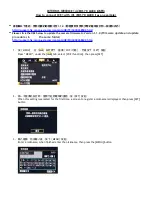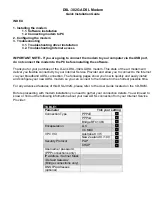
15 Basics
191
particular, show a very unstable (context dependent) resultant probability, and it must be
reckoned that particularly these characters would lead to a decrease in the effective
transmission speed with (non-adaptive) Markov compression.
The
SCS
team, in developing PT-II, came up with a simple and clever answer to these
problems. The Markov compression would be limited to the 16 most common
leading
characters. All other characters result in normal Huffman compression. We have thus a
hybrid of Markov and Huffman coding, that we have named "pseudo Markov coding. The
coding table remains reasonably small, and the uncommon characters can no longer cause
trouble due to their unstable probability results. In practice it has been shown that PMC
almost always produces a greater benefit compared to normal Huffman compression.
15.4
PACTOR-2 in practice
15.4.1
General points
Those experienced users of PACTOR-1 should have no trouble changing to PACTOR-2,
particularly if they know the usual commands of the
SCS
controller for PACTOR
operation. Before the first try-out on the air a check should be made, using the
MYcall
command (refer to chapter
), to see that one's own callsign has been
correctly loaded into the PTC-IIIusb from the terminal program. If this should not be the
case, then put in the callsign manually using the
MYcall
command. Other than this, it is
essential that the AF output level, together with the maximum output power in FSK and
DPSK are correctly set. For this, see the information contained in the description of the
two commands
FSKAmpl
(refer to chapter
) and
PSKAmpl
(refer to chapter
). Once that has been done, then one is ready to start. The transceiver can be
tuned to say 3583.7 kHz or 14079.0 kHz, and DL2FAK called (providing the frequency is
clear). If there is PT traffic on the chosen frequency, irrespective whether PT-1 or PT-2,
the PTC-IIIusb will automatically copy it, providing the
Listen
mode is turned on
(refer to chapter
). As with previous PTCs', a connect is started with
cmd:
C
CALLSIGN <Return>
At the very start of a link, the two controllers automatically agree to use the highest
common level. This functions with all known PACTOR-1 equipment, as these all contain
a correct implementation of the Level-1 protocol for the initial link. At present, we know
of no PT-1 implementation which does not work correctly with the automatic level setting
during the initial link-up. The user knows virtually nothing of the auto level setting
procedure and does not have to concern himself with it. In the case where a Level-2 link
is set up, the LED display jumps from
PT1:
to
PT2:
and the appearance of the tuning
indicator changes drastically in comparison to the usual FSK tuning help.
15.4.2
Speed and robustness
When compared to good old PACTOR-1, PACTOR-2 achieves an effective text
throughput of around 3 times that of PT-1 under average to poor conditions. With very
weak signals, or signals with heavy interference, PT-2 still works when PACTOR-1 will
not allow any more data to be passed. Naturally however, the speed of transfer, even with
PT-2, drops accordingly. One must get used to the fact, that, with practically inaudible
signals, one must wait 20 or 30 seconds for a new line to appear on the computer screen.
















































